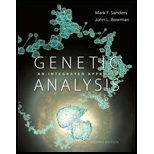
Concept explainers
Which of the following traits would you expect to be inherited as quantitative traits?
a. body weight in chickens
b. growth rate in sheep
c. milk production in cattle
d. fruit weight in tomatoes
e. coat color in dogs
To analyze:
Determine the expected quantitative traits from the following:
Body weight in chicken
Growth rate in sheep
Milk production in cattle
Fruits weight in tomatoes
Coat color in dogs
Introduction:
Multifactorial traits are the results of genetic and non-genetic variation that can contribute to the variation in phenotypes of certain traits. These multifactorial traits can be classified as quantitative traits or qualitative traits. Qualitative phenotypic variations are discontinuous variation whereas quantitative phenotypic variations are continuous variation. The effect of multiple genes which exerts same or different amount of influence on the phenotypes leads to the continuous variation in the phenotypes of polygenic traits. The influence of multiple genes leads to a number of traits called polygenic traits. The incremental contributions by multiple genes result in continuous phenotypic variation. These multiple genes are called additive genes and their effects are called additive gene effects.
Explanation of Solution
The additive effects of multiple genes contribute to the body weight of the chicken. But chickens have different body mass which suggests that each gene contributes a certain quantity of body weight. This difference in body mass is responsible for continuous variation. Therefore, it is a quantitative trait.
Continuous variation is also seen in the growth rate of sheep. The additive effect of multiple genes is responsible for different growth rates. So, the growth rate in sheep is a quantitative trait.
The amount of milk produced by each cattle is varying continuously. This suggests that the phenotypic trait is controlled by a number of genes. Each gene may add a certain quantity of milk. Therefore, milk production in cattle is a quantitative trait.
Tomatoes are also have different weights. This difference in the weight of tomatoes is contributed by different genes. This suggests that continuous variation in weight difference is an additive gene effect. Therefore, fruit weight in tomatoes is a quantitative trait.
It is observed that the coat color of the dogs is not continuously varied. Contrast is present in the coat color of dogs. Therefore, coat color in dogs is not a quantitative trait.
The quantitative traits are classified based on continuous and discontinuous phenotypic variation.
Want to see more full solutions like this?
Chapter 21 Solutions
Genetic Analysis: An Integrated Approach (2nd Edition)
Additional Science Textbook Solutions
Applications and Investigations in Earth Science (9th Edition)
Organic Chemistry (8th Edition)
Concepts of Genetics (12th Edition)
Cosmic Perspective Fundamentals
Chemistry: The Central Science (14th Edition)
Campbell Biology in Focus (2nd Edition)
- Amino Acid Coclow TABle 3' Gly Phe Leu (G) (F) (L) 3- Val (V) Arg (R) Ser (S) Ala (A) Lys (K) CAG G Glu Asp (E) (D) Ser (S) CCCAGUCAGUCAGUCAG 0204 C U A G C Asn (N) G 4 A AGU C GU (5) AC C UGA A G5 C CUGACUGACUGACUGAC Thr (T) Met (M) lle £€ (1) U 4 G Tyr Σε (Y) U Cys (C) C A G Trp (W) 3' U C A Leu בוט His Pro (P) ££ (H) Gin (Q) Arg 흐름 (R) (L) Start Stop 8. Transcription and Translation Practice: (Video 10-1 and 10-2) A. Below is the sense strand of a DNA gene. Using the sense strand, create the antisense DNA strand and label the 5' and 3' ends. B. Use the antisense strand that you create in part A as a template to create the mRNA transcript of the gene and label the 5' and 3' ends. C. Translate the mRNA you produced in part B into the polypeptide sequence making sure to follow all the rules of translation. 5'-AGCATGACTAATAGTTGTTGAGCTGTC-3' (sense strand) 4arrow_forwardWhat is the structure and function of Eukaryotic cells, including their organelles? How are Eukaryotic cells different than Prokaryotic cells, in terms of evolution which form of the cell might have came first? How do Eukaryotic cells become malignant (cancerous)?arrow_forwardWhat are the roles of DNA and proteins inside of the cell? What are the building blocks or molecular components of the DNA and proteins? How are proteins produced within the cell? What connection is there between DNA, proteins, and the cell cycle? What is the relationship between DNA, proteins, and Cancer?arrow_forward
- please fill in the empty sports, thank you!arrow_forwardIn one paragraph show how atoms and they're structure are related to the structure of dna and proteins. Talk about what atoms are. what they're made of, why chemical bonding is important to DNA?arrow_forwardWhat are the structure and properties of atoms and chemical bonds (especially how they relate to DNA and proteins).arrow_forward
- The Sentinel Cell: Nature’s Answer to Cancer?arrow_forwardMolecular Biology Question You are working to characterize a novel protein in mice. Analysis shows that high levels of the primary transcript that codes for this protein are found in tissue from the brain, muscle, liver, and pancreas. However, an antibody that recognizes the C-terminal portion of the protein indicates that the protein is present in brain, muscle, and liver, but not in the pancreas. What is the most likely explanation for this result?arrow_forwardMolecular Biology Explain/discuss how “slow stop” and “quick/fast stop” mutants wereused to identify different protein involved in DNA replication in E. coli.arrow_forward
 Human Heredity: Principles and Issues (MindTap Co...BiologyISBN:9781305251052Author:Michael CummingsPublisher:Cengage Learning
Human Heredity: Principles and Issues (MindTap Co...BiologyISBN:9781305251052Author:Michael CummingsPublisher:Cengage Learning Concepts of BiologyBiologyISBN:9781938168116Author:Samantha Fowler, Rebecca Roush, James WisePublisher:OpenStax College
Concepts of BiologyBiologyISBN:9781938168116Author:Samantha Fowler, Rebecca Roush, James WisePublisher:OpenStax College Human Biology (MindTap Course List)BiologyISBN:9781305112100Author:Cecie Starr, Beverly McMillanPublisher:Cengage Learning
Human Biology (MindTap Course List)BiologyISBN:9781305112100Author:Cecie Starr, Beverly McMillanPublisher:Cengage Learning





